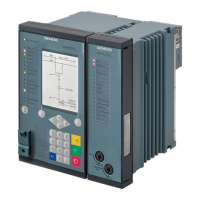Direction Determination
Logic of Direction Determination
The following figure represents the logic of the direction determination. It applies to all types of stages.
[lodirdet-280812-01.tif, 1, en_US]
Figure 7-105 Logic Diagram of Direction Determination
Measurand for the Direction Determination
With the parameter Polarization with you define whether the direction determination is calculated with
the zero-sequence components 3I0 and V0 or with the negative-sequence components I2 and V2, which are
present during faults in the network.
The angle between IN (=-3I0) and V0 (respectively -I2 and V2) in case of using the negative-sequence compo-
nents is available as a functional measured value. This value is only present during faults in the network.
[DwUIkenn-240812-01.vsd, 1, en_US]
Figure 7-106 Measured-Value Definition
Start of the Direction Determination
If the zero-sequence current 3I0 exceeds the pickup threshold of a stage and the selected voltage (V0 or V2)
exceeds the parameter Min. voltage V0 or V2 as well, the direction determination is started.
Direction Determination with Zero-Sequence Values
The direction is determined by calculating the phase angle between the short-circuit current -3I0 and the
rotated reference voltage V
ref, rot
. Contrary to the Directional overcurrent protection, phase function, which
works with the healthy voltage as reference voltage, the fault voltage V0 itself is the reference voltage for the
Directional overcurrent protection, ground function. To take different system conditions and applications
7.7.3.2
Protection and Automation Functions
7.7 Directional Overcurrent Protection, Ground
SIPROTEC 5, High-Voltage Bay Controller, Manual 703
C53000-G5040-C015-9, Edition 11.2017

